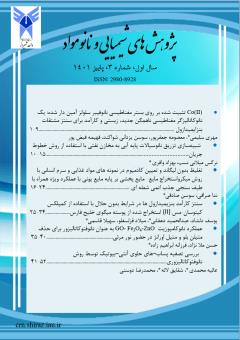عملکرد نانوکامپوزیت GO- Fe3O4-ZnO به عنوان نانوفتوکاتالیزور برای حذف متیلن بلو و متیل اورانژ در حضور نور مرئی
محورهای موضوعی : اندازه گیری گونه ها
حسن ملانژاد
1
![]() ,
فرزانه ابراهیم زاده
2
,
فرزانه ابراهیم زاده
2
![]()
1 - گروه شیمی ، واحد مرودشت، دانشگاه آزاد اسلامی، مرودشت، ایران
2 - گروه شیمی ، واحد مرودشت، دانشگاه آزاد اسلامی، مرودشت، ایران
کلید واژه: نانوکامپوزیت, متیلن بلو, اکسید گرافن, فتوکاتالیزور,
چکیده مقاله :
در این مقاله، اکسید گرافن با اکسید آهن مغناطیسی ترکیب میشود و پس از افزوده شدن نانو ذرات اکسید روی، نانوکامپوزیت فتوکاتالیزوری مغناطیسی بر پایه اکسید گرافن حاصل می شود که به راحتی قابل جداسازی در حضور میدان مغناطیسی است. خواص نانوکامپوزیت توسط مطالعات مغناطیس سنج نمونه ارتعاشی و میکروسکوپ الکترونی روبشی گسیل میدانی بررسی شد. از این نانوکامپوزیت به عنوان فتوکاتالیزور برای حذف آلودگی رنگی از جمله متیلن بلو و متیل اورانژ در حضور نور مرئی استفاده شد. نتایج مطالعات حذف آلودگی رنگ ها با طیف سنج مرئی نشان داد که حذف رنگ متیلن بلو به صورت کامل در زمان کوتاه و در مجاورت نور خورشید انجام می شود. از مزایای نانوکامپوزیت فوق می توان به سنتز بسیار ارزان، راحت و مقرون به صرفه بودن آن اشاره کرد.
In this paper, graphene oxide is applied as a substrate for the synthesis of the magnetic graphene oxide-zinc oxide nanocomposite. The prepared nanocomposite (GO–ZnO–Fe3O4) are characterized using Field emission scanning electron microscopy(FESEM) and vibrating sample magnetometer(VSM). The photocatalytic performance of the synthesized samples is evaluated according to the photodegradation of methylene blue and methyl orang as organic dyes pollutant. The results of studies on the removal of dye pollution with a UV-Vis spectrometer showed that the removal of methylene blue dye is done completely in a short time and in the presence of sunlight. One of the advantages of the above nanocomposite is its very cheap, convenient and cost-effective synthesis.
1. A. Khataee, A. Karimi, R. D. C. Soltani, M. Safarpour, Y. Hanifehpour, S. W. Joo, Appl. Catal., A 488, 160 (2014)
2. H. Wang, X. Li, X. Zhao, C. Li, X. Song, P. Zhang, P. Huo, X. Li., Chinese J. Catal. 43(2), 178-214 (2022)
3. P. Jantawasu, T. Sreethawong, S. Chavadej, Chem. Eng. J. 155, 223 (2009)
4. R. Cheng, J. Xia, J. Wen, P. Xu, X. Zheng J. Nanomater. 12(8), 1335 (2022)
5. N. T. Nguyen, V. A. Nguyen. J. Nanomater, 1-8 (2020)
6. D. Chen, D. Wang, Q. Ge, G. Ping, M. Fan, L. Qin, L. Bai, C. Lv, K. Shu, Thin Solid Films 574, 1 (2015)
7. Ahmad, M.; Ahmed, E.; Hong, Z. L.; Xu, J. F.; Khalid, N. R.; Elhissi, A.; Ahmed, W.; Appl. Surf. Sci. 274, 273 (2013)
8. A. Adetayo, D. Runsewe., Open J. Compos. Mater. 9(02), 207 (2019).
9. S. Bai, X. Shen, X. Zhong, Y. Liu, G. Zhu, X. Xu, K. Chen, Carbon 50, 2337 (2012)
10. M. Ahmad, E. Ahmed, Z. L. Hong, J. F. Xu, N. R. Khalid, A. Elhissi, W. Ahmed, Appl. Surf. Sci. 274, 273 (2013)
11. P. P. Briseboisa, M. Siaj.J. Mater. Chem. C, 8(5), 1517-1547. (2020).
12. Z. Esania, H. Younesi, M. Nowrouzi, H Karimi-Maleh. J. Water Process. Eng. 47, 102750 (2022)
13. A. B. Djurišić, Y. He, A. M. C. Ng, APL Mater 8(3), 030903. (2020)
14. L. Y. Chen, Z. Lin, C. L. Zhao, Y. Y. Zheng, Y. Zhou and H. Peng, J. Alloys Compd., 509, L1–L5 (2011),
15. Rauf, M.A.; Ashraf S.S. J. Chem. Eng. 151, 10-18 (2009)
16. X. Feng, X. Lou, Sep. Purif. Technol., 147, 266-275 (2015)


